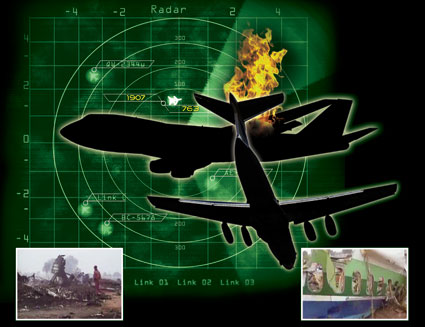Accident Analysis - Collision In The Corridor
The Charkhi Dadri disaster, some observers claim, was waiting to happen because there had been several near-misses mostly involving airlines from the former Soviet republics, whose flight crew lacked sufficient familiarity with English

Two decades or so ago, it was unlikely that the name Charkhi Dadri would have elicited any reaction beyond the borders of Haryana, but in November 1996, the town gained worldwide notoriety as the site of India’s worst ever air accident. The result of a merging of two adjacent villages, Charkhi Dadri is a small town about 74 km as the crow flies from Delhi airport. The evening sky was lit up as two fireballs plunged to the earth about 4 km below when a Saudi Arabian Airlines Boeing 747-168B and an Air Kazakhstan Ilyushin Il-76 collided in the skies above Charkhi Dadri. All 349 passengers and crew on board the two airliners were killed, making it the deadliest mid-air collision in history. Collisions between military aircraft or between light aircraft have occurred but the last collision involving two commercial airliners had taken place more than 17 years earlier on August 11, 1979, when two Aeroflot Tupolev Tu-134s had collided over Ukraine killing 165 people.
Routine Becomes Disastrous
Dusk was approaching as the Saudi Arabian Airlines Flight 763 departed Delhi’s Indira Gandhi International Airport at 1832 hours on November 12, 1996, and headed for Dharan in Saudi Arabia. It had 312 people on board, including 23 crew members. Captain Khalid Al Shoubaili was in command. The passengers included 215 Indians mainly blue collar workers in search of employment in Saudi Arabia and several Hajj pilgrims. Flight 763 was cleared to climb on a westerly course (270°) from the Delhi VOR Navigation Beacon (DPN) on Airway G452 to FL 140 (14,000 ft). Although it wished to climb further, this request was not granted by the Delhi Air Traffic Control (ATC). The reason was that a reciprocal flight was expected in the same corridor at a higher level.
Kazakhstan Airlines Flight 1907, an Il-76 chartered by a Kyrgyzstan-based company, had just 27 passengers and 10 crew members on board. The flight, with Captain Gennadi Cherepanov in command, took off from Chimkent in Kazakhstan and was destined for Delhi carrying mainly Kyrgyz nationals on a shopping expedition. While descending on Airway G452, on an easterly course (090°), the crew contacted Delhi approach 74 nm from the DPN beacon. The approach controller instructed the flight to descend to and maintain FL 150 (15,000 ft).
Around 1840 hours, the Il-76 reported having reached FL 150, but later Flight Data Recorder (FDR) analysis showed it at 16,000 ft at the time. The Delhi approach controller responded: “Roger, maintain FL 150, identified traffic 12 o’clock, reciprocal Saudia Boeing 747, 14 miles. Report in sight.” Another aircraft airborne in the vicinity later reported that there was considerable cumulus clouding in the area, so spotting the reciprocal aircraft, even one as huge as a Boeing 747, may not have been easy. At this stage, both aircraft, although travelling directly towards each other, were supposed to be separated by 1,000 ft vertically. When the Il-76 crew asked for a repeat of the distance, the controller replied, “14 miles now”. Since this call was not acknowledged, the controller again warned: “Traffic is 13 miles, level 140”. This time the crew acknowledged the transmission. The Il-76 was again informed by the Delhi controller, 38 seconds before impact, that the Boeing 747 was just eight miles away, approaching the Ilyushin at 14,000 ft. However, according to the Ilyushin’s FDR, 26 seconds before the collision, the plane was at 14,190 ft, just above the 14,000 ft altitude that the approach controller had assigned to the Saudi plane, and still descending. In the cockpit of the Il-76, the radio operator grew alarmed. He twice urged his captain to gain height to 15,000 ft but it was too late.
On the approach controller’s radar screen the rapidly converging blips of the two airliners merged. The planes had collided almost head-on. The tail of the Il-76 had sliced through the left wing of the Boeing 747. The Boeing lost an aileron and, as a result, went into a steep, descending spiral. All passengers and crew on board both flights perished.
Common Corridor
The official Commission of Inquiry held in Delhi determined that the Il-76 had descended from the assigned altitude of 15,000 ft to 14,500 ft and subsequently to 14,000 ft, perhaps even below that, before it started climbing, putting it directly at the height of 14,000 ft assigned to the Boeing 747. This fatal lapse in operating procedure could have been due to the Kazakh pilots’ unfamiliarity with English as they were relying entirely on their radio operator for communication with the ATC. Actually, there were two types of translations going on between the crew of the Kazak plane. All radio exchanges between the approach controller and radio operator were in English while the captain and his co-pilot were probably more familiar with Russian. And since the Il-76 instruments were calibrated in the metric system, the internationally recognised feet-based instructions of the controller had to be converted into metres. This may have taken some time. Seconds before impact, the captain had asked the radio operator what altitude they were supposed to be at.





